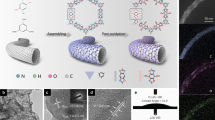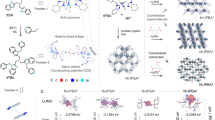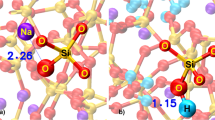Abstract
THE exchange of metal ions between an oxide mineral surface and water occurs in a wide range of processes, including corrosion1, the breakdown of inhaled dusts2,3, soil formation4 and the cycling of toxic substances in the environment5. In studies of the mechanisms of dissolution, the measured rate-law order with respect to protons6–15 cannot be reconciled with the number of protons needed to form any reasonable assumed activated complex. Here we suggest that this discrepancy can be avoided if one takes into account the number of protonation and deprotonation steps leading to detachment of the hydrated metal ion. We show that the experimental proton rate order reflects a net balance of protons removed and attached in these steps. Our mechanism explains why the rate order generally coincides with the metal valence8,9,11,12,16–18, and why there is a similarity between rates of water ligand lability in dissolved complexes and rates of mineral dissolution19–22 and metal desorption23. It eliminates the need to invoke catalysis by protons, and establishes a close consistency between reactions at surfaces and (better understood) ligand-exchange reactions in solution.
This is a preview of subscription content, access via your institution
Access options
Subscribe to this journal
Receive 51 print issues and online access
$199.00 per year
only $3.90 per issue
Buy this article
- Purchase on SpringerLink
- Instant access to full article PDF
Prices may be subject to local taxes which are calculated during checkout
Similar content being viewed by others
References
Blesa, M. A., Morando, P. J. & Regazzoni, A. E. Chemical Dissolution of Metal Oxides (CRC, Boca Raton, FL, 1994).
Kuhn, D. C. & Demers, L M. J. Toxicology and Environmental Health 35, 39–50 (1992).
Hochella, M. F. in Health Effects of Mineral Dusts (eds Guthrie, D. G. & Mossman, B. T.) 275–305 (Rev. Mineral. 28, Mineral. Soc. Am., 1993).
Hilgard, E. W. Soils: Their Formation, Properties, Compositions and Relations to Climate and Plant Growth in the Humid and Arid Regions 19 (MacMillan, New York, 1914).
Davis, J. A. & Leckie, J. O. in Chemical Modeling in Aqueous Systems (ed. Jenne, E. A.) (Am. chem. Soc., Washington DC, 1979).
Wirth, G. S. & Gieskes, J. M. J. Colloid Interface Sci. 68, 492–500 (1979).
Blum, A. & Lasaga, A. C. Geochim. cosmochim. Acta 55, 2193–2201 (1991).
Furrer, G. & Stumm, W. Geochim. cosmochim. Acta 50, 1847–1860 (1986).
Wieland, E., Wehrli, B. & Stumm, W. Geochim. cosmochim. Acta 52, 1969–1981 (1988).
Ganor, J., Mogollòn, J. L. & Lasaga, A. C. Geochim. cosmochim. Acta 59, 1037–1053 (1995).
Stumm, W. Chemistry of the Solid-Water Interface (Wiley, New York, 1992).
Stumm, W. & Wollast, R. Rev. Geophys. 28, 53–69 (1990).
Carroll-Webb, S. A. & Walther, J. V. Geochim. cosmochim. Acta 52, 2609–2623 (1988).
Pulfer, K., Schindler, P. W., Westall, J. C. & Grauer, R. J. Colloid Interface Sci. 101, 554–564 (1984).
Oelkers, E. H. & Schott, J. Geochim. cosmochim. Acta 59, 5039–5054 (1995).
Guy, C. & Schott, J. Chem. Geol. 78, 181–204 (1989).
Ludwig, C. & Casey, W. H. J. Colloid Interface Sci. 178, 176–185 (1996).
Furrer, G. thesis, ETH Zurich (1985).
Casey, W. H. J. Colloid Interface Sci. 146, 586–589 (1991).
Casey, W. H. & Westrich, H. R. Nature 355, 157–159 (1992).
Ludwig, C., Casey, W. H. & Rock, P. A. Nature 375, 44–47 (1995).
Dove, P. M. & Czank, C. A. Geochim. cosmochim Acta 59, 1907–1916 (1995).
Hachiya, K., Sasaki, M., Ikeda, T., Mikami, N. & Yasunaga, T. J. phys. Chem. 88, 27–31 (1984).
Ludwig, C., Devidal, J.-L. & Casey, W. H. Geochim. cosmochim. Acta 60, 213–224 (1996).
Gratz, A. J., Manne, S. & Hansma, P. K. Science 251, 1343–1346 (1991).
Hochella, M. F. in Mineral-Water Interface Geochemistry (eds Hochella, M. F. & White, A. F.) Ch. 3 (Rev. Mineral. 23, Mineral. Soc. Am., Washington DC, 1990).
Casey, W. H., Westrich, H. R., Banfield, J. F., Feruzzi, G. & Arnold, G. Nature 366, 253–256 (1993).
Casey, W. H. & Bunker, B. in Mineral-Water Interface Geochemistry (eds Hochella, M. F. & White, A. F.) Ch. 9 (Rev. Mineral. 23, Mineral. Soc. Am., Washington DC,1990 ).
Author information
Authors and Affiliations
Rights and permissions
About this article
Cite this article
Casey, W., Ludwig, C. The mechanism of dissolution of oxide minerals. Nature 381, 506–509 (1996). https://doi.org/10.1038/381506a0
Received:
Accepted:
Issue date:
DOI: https://doi.org/10.1038/381506a0
This article is cited by
-
Derivation of a Ni bioaccessibility value for screening-level risk assessment of Ni substances in ingested materials including soils
Environmental Geochemistry and Health (2022)
-
Mineral dissolution and reprecipitation mediated by an amorphous phase
Nature Communications (2018)
-
Characterisation of a garnet population from the Sikkim Himalaya: insights into the rates and mechanisms of porphyroblast crystallisation
Contributions to Mineralogy and Petrology (2017)
-
Effects of sp2- and sp3-carbon coatings on dissolution and electrochemistry of water-based LiFePO4 cathodes
Journal of Applied Electrochemistry (2017)
-
Bonding and reactivity at oxide mineral surfaces from model aqueous complexes
Nature (2000)



